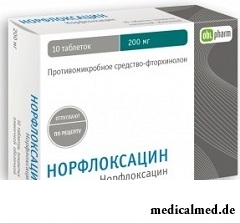





Norfloxacin
Application instruction:
 Norfloxacin – antimicrobic drug from group of ftorkhinolon.
Norfloxacin – antimicrobic drug from group of ftorkhinolon.
Form of release and structure
Norfloxacin is produced in the form of tablets, film coated: yellow, biconvex, oblong with the rounded ends, on one party – risk; on cross section – two layers, an inside layer of pale yellow or white color (on 10 pieces in blister strip packagings from a polyvinyl chloride film and the varnished printing aluminum foil, on 1 or 2 packagings in a cardboard pack).
Is a part of 1 tablet:
- Active agent: norfloxacin – 200 or 400 mg;
- Auxiliary components (200/400 mg of active agent respectively): aerosil (colloid silicon dioxide) – 3,6/7,2 mg, magnesium stearate – 3,6/7,2 mg, microcrystallic cellulose – 120,4/240,8 mg, croscarmellose sodium – 10,8/21,6 mg, кросповидон – 21,6/43,2 mg;
- Cover (200/400 mg of active agent respectively): a gidroksipropilmetiltsellyuloz (gipromelloz) – 6,57/13,14 mg, polyethyleneglycol 6000 (a macrogoal 6000) – 2,2/4,4 mg, titanium dioxide – 2,2/4,4 mg, yellow quinolinic dye – 0,03/0,06 mg.
Indications to use
Norfloxacin is appointed for treatment of the infections caused by microorganisms, sensitive to effect of active agent, including prostatitis, uncomplicated gonorrhea, infections of urinary tract (except for the chronic complicated and acute pyelonephritis).
Contraindications
Absolute:
- Deficit glyukozo-6-fosfatdegidrogenazy;
- The rupture of a sinew and tendinitis connected with reception of ftorkhinolon (including anamnestic data);
- Children's age up to 18 years;
- Period of pregnancy and lactation;
- Hypersensitivity to drug components.
Relative (Norfloxacin is appointed with care in the presence of the following diseases / states):
- Epilepsy;
- Liver/renal failure;
- Convulsive syndrome;
- gravis myasthenia.
Route of administration and dosage
Norfloxacin is accepted inside.
The mode of dosing is defined by indications.
Treatment:
- Infections of urinary tract: 2 times a day on 400 mg, the average duration of a course – 7-10 days, uncomplicated cystitis – 3-7 days, persistent recurrent infections of urinary tract – up to 3 months;
- Acute bacterial gastroenteritis: 2 times a day on 400 mg, the average duration of a course – 5 days;
- Acute gonococcal urethritis, pharyngitis, proctitis, cervicitis: 800 mg once;
- Typhoid: 3 times a day on 400 mg, the average duration of a course – 2 weeks.
Prevention:
- Sepsis: 2 times a day on 400 mg;
- Bacterial gastroenteritis: on 400 mg a day;
- Diarrhea of travelers: on 400 mg a day (it is necessary to begin administration of drug in 1 day prior to departure, therapy is continued throughout the entire period of a way, but not longer by 3 weeks);
- Recurrence of infections of urinary tract: on 200 mg a day.
Use of the lowered daily doses (1/2 therapeutic doses 2 times a day or a full single dose once a day) is required to patients at clearance of creatinine lower than 20 ml a minute (or concentration of serumal creatinine more than 5 mg / 100 by ml), and also the patient who is on a hemodialysis.
Side effects
- Cardiovascular system: heart consciousness, myocardial infarction;
- Central nervous system: a sleep disorder, a headache, dizziness, a pricking in fingers of hands, alarm, drowsiness, sleeplessness, a depression;
- Urinary systems: renal colic;
- Alimentary system: diarrhea, nausea, an anus itch, anorexia, an abdominal pain, heartburn, pains in a rectum or an anus, dyspepsia, a lock, not properly executed chair, a meteorism, vomiting, dryness of a mucous membrane of an oral cavity, an ulceration of a mucous membrane of an oral cavity, bitter smack in a mouth;
- Hemopoietic system: eosinophilia, leukopenia, thrombocytopenia, neutropenia;
- Skeletal and motive device: bursitis, puffiness of feet and brushes;
- Sense bodys: illegibility of visual perception;
- Integuments: itch, erythema, rash, urticaria;
- Laboratory indicators: decrease in hemoglobin and a hematocrit, increase in activity of aspartate aminotransferase, alaninaminotranspherase, an alkaline phosphatase, lactate dehydrogenase, a proteinuria, a giperkreatininemiya, increase in concentration of urea in blood, a glucosuria;
- Others: allergic reactions, fever, hyperhidrosis, hypostases, adynamy, fever, dorsodynia and breasts, dysmenorrhea.
As a result of carrying out post-market researches the following disturbances were recorded:
- Central nervous system: peripheral neuropathy, spasms, a tremor, a myoclonia, a syndrome to Giyena-Barra, an ataxy, a hypesthesia, paresthesias, mental disturbances (including confusion of consciousness);
- Cardiovascular system: lengthening of an interval of QT, ventricular arrhythmia (including tachycardia like "pirouette");
- Skeletal and motive device: gravis myasthenia aggravation, rupture of a sinew, tendinitis, increase in activity of a kreatinfosfokinaza;
- Urinary system: renal failure, intersticial nephrite;
- Alimentary system: hepatitis, stomatitis, pseudomembranous colitis, cholestatic jaundice, pancreatitis, a liver failure (including with a lethal outcome);
- Hemopoietic system: hemolitic anemia, agranulocytosis;
- Sense bodys: diplopia, sonitus, decrease in hearing, dysgeusia;
- Integuments: toxic epidermal necrolysis, Stephens-Johnson's syndrome, exfoliative dermatitis, mnogoformny erythema, photosensitization;
- Allergic reactions: Quincke's disease, anaphylactoid reactions, asthma, vasculitis, arthralgia, arthritis, mialgiya;
- Others: hypoglycemia, lengthening of a prothrombin time, albuminuria, kandiduriya, cylindruria, crystalluria, dysphagy, hyperglycemia, hyperpotassemia, hypercholesterolemia, postural hypotension, gipertriglitseridemiya, hamaturia, liver necrosis, nystagmus, vagina candidiasis.
Special instructions
During therapy patients under control of a diuresis have to receive adequate amount of liquid.
During use of Norfloxacin the prothrombin ratio can increase (surgical interventions need to be carried out under control of a condition of system of a blood coagulation).
Administration of drug increases probability of development of a tendinitis and rupture of sinews. Treats risk factors: the chronic renal failure, transplantation of a kidney, lung or heart, age is more senior than 60 years, a combination therapy with glucocorticosteroids, the increased physical activity, damage of sinews in the anamnesis (including a pseudorheumatism). These disturbances can develop also in several months after end of a course. At emergence of the first signs of a tendinitis or rupture of a sinew it is necessary to interrupt administration of drug and to address the specialist.
During therapy it is necessary to avoid impact of a direct sunlight.
Norfloxacin can lower a threshold of convulsive readiness and lead to emergence of spasms. Also ftorkhinolona can stimulate the central nervous system, causing hallucinations, concern, a tremor, toxic psychoses, confusion of consciousness and to promote increase in intracranial pressure.
Norfloxacin can lead to development of the caused Clostridium difficile of pseudomembranous colitis. In these cases it is necessary to cancel drug and to appoint the corresponding therapy (use of metronidazole or Vancomycinum orally).
At treatment of syphilis Norfloxacin is not appointed (drug is not effective).
It is not necessary to exceed the recommended dosing mode as it can lead to formation of crystals of active agent in kidneys.
Norfloxacin can cause peripheral neuropathy (in the form of paresthesias, a hypesthesia, dizesteziya, muscular weakness). To avoid development of irreversible changes, at emergence of the first symptoms of a disease (a pricking, pain, weakness or numbness in extremities, disturbance of other types of sensitivity) therapy should be cancelled.
During control of vehicles and performance of potentially dangerous works demanding bystry psychomotor reactions and the increased concentration of attention it is necessary to be careful (in particular at the simultaneous use with ethanol).
Medicinal interaction
At combined use of Norfloxacin with some drugs there can be following effects:
- Theophylline: decrease in its clearance (decrease in its dose is required);
- Nitrofurans: decrease in their efficiency;
- Indirect anticoagulants, cyclosporine: increase in their concentration in blood serum;
- The drugs reducing a threshold of convulsive readiness (including nonsteroid antiinflammatory medicines): development of spasms;
- Antacids with the content of aluminum or magnesium hydroxide, and also the drugs containing сукральфат, Zn2+, Fe: decrease in absorption of norfloxacin (the break between their use has to make not less than 4 hours);
- CYP1A2 isoenzymes (including ропинирол, caffeine, clozapine, theophylline, такрин, тизанидин): increase in concentration of its substrates in blood;
- Probenetsid: decrease in excretion of norfloxacin;
- Glibenclamidum: development of a heavy hypoglycemia;
- Antacids, диданозин, сукральфат, polyvitamins with the content of zinc: decrease in absorption of norfloxacin (the break between their use has to make not less than 2 hours).
Terms and storage conditions
To store in protected from light, the place, dry, unavailable to children, at a temperature up to 25 °C.
Period of validity – 2 years.
Name of drug
Price
Drugstore
The most high temperature of a body was recorded at Uilli Jones (USA) who came to hospital with a temperature of 46,5 °C.

Memory is an ability of the central nervous system to fix, keep and as necessary to reproduce information on knowledge...
Section: Articles about health
You heard that laughter prolongs life? Researchers did not manage to establish longevity direct link with sincere fun yet, but several facts confirming beneficial influence of risibility on the state of health are clinically proved....
Section: Articles about health
Visit of doctors – business not the most pleasant, and many people do not hurry to undergo necessary planned inspections. Such behavior is extremely thoughtless and improvident. Our health is necessary not only to us: wellbeing of darlings, children, grandsons and aged parents directly depends on as far as we are vigorous and able-bodied. Therefore in time to be inspected – a duty of any modern person. Specialists consider that 7 regular surveys and di are especially necessary for women...
Section: Articles about health
Bulimia and anorexia, are heavy deviations of a feeding behavior, become a cause of death of patients much more often than all others...
Section: Articles about health
All know that self-treatment is dangerous. However absolutely it is almost impossible to do without it. Rate of modern life does not allow to handle each small trouble to the doctor and information on ways of independent rendering medical the help...
Section: Articles about health
Color of plants is caused by presence at them of certain chemical compounds. Let's talk about what is meant by various colors of vegetables and fruit and what properties they give them....
Section: Articles about health
Sooner or later hair turn gray at all. Many people try to hide these changes, returning natural color of the hair with the help about...
Section: Articles about health
Subfebrile temperature call fervescence to 38 degrees, and subfebrile condition - existence of such temperature over 3 days, and quite often it happens without the visible reasons. Existence of subfebrile condition - a strong indication of disturbances in an organism which can...
Section: Articles about health
The body of the person almost for 60% consists of water. It is so important for normal functioning of an organism that loss of only one and a half percent of liquid already leads to the most unpleasant effects. The problems connected with deficit of water can overtake also the healthiest person if he, for example, spends several hours under the scorching sun, without having taken with themselves drink, but is very simple to correct health in this case. It is much more difficult to minimize effects of other reasons about...
Section: Articles about health
All of us, unfortunately, should face flu nearly an every year. It would seem, so frequent disease has to be study...
Section: Articles about health
Osteoporosis this general disease which main sign is decrease in density of a bone tissue. On distribution width it takes the fourth place among noninfectious diseases. The illness develops at mature age more often: in our country to them harvest seasons...
Section: Articles about health
(Xerostomia) many people consider feeling of a xerostomia small and easily removable inconvenience. This delusion: the symptom can demonstrate existence of serious diseases. It is worth to remember also that saliva performs important functions in an organism: clears the surface of teeth of a food plaque, growth of pathogenic microorganisms oppresses, normalizes acid-base balance, liquefies food and helps to split the carbohydrates which are contained in it. Chronic deficit слюн...
Section: Articles about health
Producers of milk mixes for children assure: mixes are ideally balanced and adapted for needs of babies. If mother should raise artificially the kid owing to serious problems with health, to do nothing – it is necessary to feed with substitutes of milk. However pediatricians note that not seldom women without good reasons refuse feeding of the child a breast and pass to milk mixes. Common causes of such decision – the aspiration to leave quicker...
Section: Articles about health
Aging — natural and inevitable process. Over time our skin loses elasticity, on it saggings, a face form теря are formed...
Section: Articles about health
For many spouses the question of planning of a family is one of the main. The problem of the choice of effective and safe contraceptives at the same time comes out on top. Russians still not often resort to operation of a vasectomy extremely popular in the USA...
Section: Articles about health
For the person who daily since morning gathers for work it is very important to wake up vigorous and ready by day of work. Actually, each of us experiences difficulties with this, at first sight, simple business from time to time. After night rest exert impact on a condition of an organism the weather which collected for several days fatigue, household and office problems, quality of a dream and many other factors....
Section: Articles about health
Insufficiently strongly expressed sexual desire or lack of satisfaction from sexual contacts can test time from in...
Section: Articles about health
Musicotherapy – a treatment method which caused and causes a set of a controversy concerning its efficiency. However the facts are relentless: during the numerous researches curative impact of music on an organism was scientifically confirmed. Since then in a number of the countries a method...
Section: Articles about health
Olive oil – the product capable to make a powerful contribution to health of the person if it includes it in the diet. The rich vitamin composition of oil does it by a product number one from many diseases including from deadly. Only two tablespoons of oil from olives in day prevent emergence of diseases of vessels and heart, cancer, problems with digestion, presenilation, a depression and many other illnesses which treatment would demand a lot of time and forces. Let's consider on...
Section: Articles about health
Beauty shop – the place which is associated only with positive emotions: joy, pleasure, relaxation. One...
Section: Articles about health
Statistically cystitis 25-30% of women up to 40 years have. With age this indicator raises, besides many do not get to statistics because do not see a doctor. The most sad that after the regular visits to doctors, long reception of antibiotics...
Section: Articles about health
The words "disease" and "patient" not without reason come from one root – "pain". As a rule, symptoms of illnesses thoroughly spoil to patients life. However from this rule there are exceptions. Some diseases are shown by signs which can cause even positive emotions. It is a pity only that the majority of such illnesses are heavy and incurable....
Section: Articles about health
Among a set of the perfumery and cosmetic goods which are released today the special group is made by the means containing anti-bacterial...
Section: Articles about health
80% of women at least once to lives complained of discomfortable feelings to breasts, consolidations and nagrubaniye. These are mastopathy symptoms. The mastopathy is characterized by change of a ratio between ferruterous and connective tissue tissues of mammary glands. It can bring...
Section: Articles about health
Some people consider what for medicine of the 21st century of secrets in the field of health of the person almost does not exist. It absolutely not so. The more answers scientists receive, the more the most difficult questions are raised for them by life. Besides, there are diseases which are not explained with science in any way of which existence people know for 100-150 years. These diseases meet not so often, but from some of them nobody is insured....
Section: Articles about health



